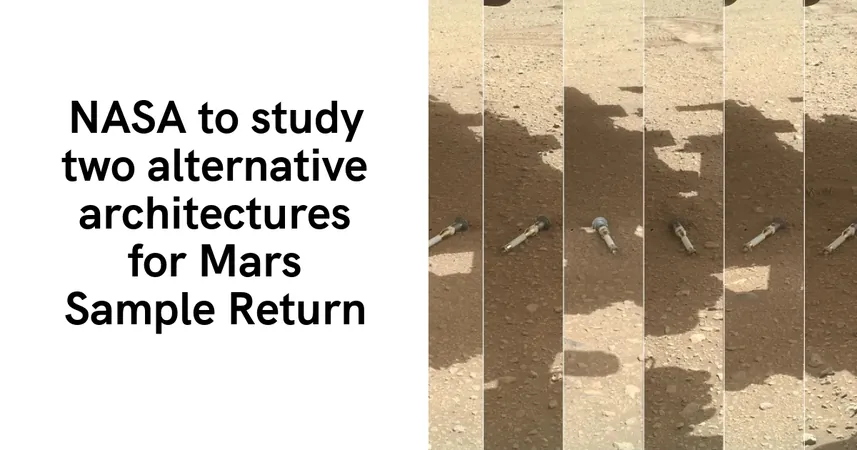
NASA Takes Exciting Steps for Mars Sample Return: Two Bold Approaches Unveiled!
2025-01-07
Author: Jessica Wong
NASA Takes Exciting Steps for Mars Sample Return: Two Bold Approaches Unveiled!
In a thrilling announcement that has captured the imagination of space enthusiasts around the globe, NASA revealed its plans to rigorously explore two potential strategies for bringing back samples from Mars! This groundbreaking initiative, which aims to harness new technologies as well as lessons learned from previous missions, is set to unfold over the next 18 months.
NASA's leadership disclosed on January 7 that its Mars Sample Return (MSR) mission could see Martian samples currently collected by the Perseverance rover returned to Earth by as early as 2035. But how can NASA accomplish such a monumental task? The agency is contemplating two very different architectures, each with its own unique landing methods for delivering a redesigned sample retrieval lander to the Martian surface.
The first proposed option, which NASA Administrator Bill Nelson estimates will cost between $6.6 billion and $7.7 billion, would utilize "sky crane" technology, famously employed in past successful landings of the Perseverance and Curiosity rovers by the Jet Propulsion Laboratory (JPL). Notably, this method could significantly cut costs — slashing initial MSR budget estimates from $11 billion in half!
On the other hand, the second approach — with projected costs ranging from $5.8 billion to $7.1 billion — suggests deploying a commercially sourced “heavy lander.” While NASA has not yet disclosed which commercial companies might be involved, speculation arises around industry giants like Blue Origin and SpaceX, both of which have contracts related to technology that could be utilized for lunar landers.
“The crucial difference between these two options lies in the landing mechanisms,” stated Nicky Fox, NASA's associate administrator for science. Despite the differences, both systems aim to deliver a revamped sample retrieval platform designed to overcome harsh dust storms on Mars — this new technology will feature a radioisotope thermoelectric generator (RTG) to provide power rather than relying on potentially unreliable solar panels.
Also of note is the redesigned sample loading system that would securely transfer sample tubes from the Perseverance rover to the lander while ensuring planetary protection against possible contamination when the samples arrive back on Earth.
As NASA's exploration efforts ramp up, the timeline for this ambitious project hinges on funding from Congress. For the MSR mission to stay on track, at least $300 million is required in the fiscal year 2025 appropriations bill. The back-and-forth negotiations in Congress currently leave the final budget unclear, but there is hope that a successful allocation will pave the way for a launch of the European Space Agency's (ESA) orbiter in 2030, with the first sample retrieval lander set to follow as soon as 2031. If all goes to plan, Martian samples could return no earlier than 2035 and potentially as late as 2039.
Interestingly, this race to return Martian samples has sparked competition with China, which plans to launch its own sample retrieval mission as early as 2028. While some may view this as a potential threat, Nelson voiced skepticism about comparing the two missions, emphasizing that China's approach appears to be a simple “grab and go” method rather than the comprehensive, science-driven exploration NASA aims to achieve.
The excitement surrounding these Martian samples is palpable! NASA officials like Laurie Leshin, director of JPL, underscored the importance of the materials being collected by Perseverance, including an intriguing sample thought to possess ancient biosignatures. The anticipation of returning to Earth with this data not only highlights the scientific merit but stirs curiosity about the potential for uncovering life's mysteries on Mars.
Get ready, space lovers — NASA’s Mars Sample Return mission is moving forward with a bang, and the future of interplanetary exploration looks more promising than ever!




 Brasil (PT)
Brasil (PT)
 Canada (EN)
Canada (EN)
 Chile (ES)
Chile (ES)
 Česko (CS)
Česko (CS)
 대한민국 (KO)
대한민국 (KO)
 España (ES)
España (ES)
 France (FR)
France (FR)
 Hong Kong (EN)
Hong Kong (EN)
 Italia (IT)
Italia (IT)
 日本 (JA)
日本 (JA)
 Magyarország (HU)
Magyarország (HU)
 Norge (NO)
Norge (NO)
 Polska (PL)
Polska (PL)
 Schweiz (DE)
Schweiz (DE)
 Singapore (EN)
Singapore (EN)
 Sverige (SV)
Sverige (SV)
 Suomi (FI)
Suomi (FI)
 Türkiye (TR)
Türkiye (TR)
 الإمارات العربية المتحدة (AR)
الإمارات العربية المتحدة (AR)